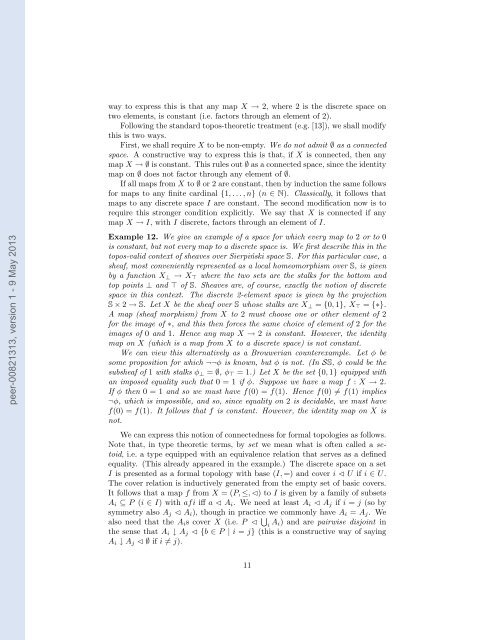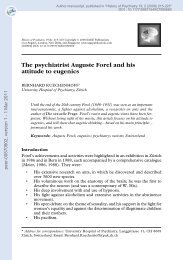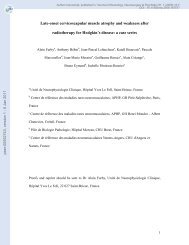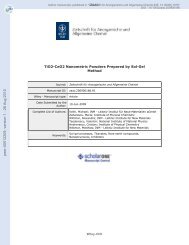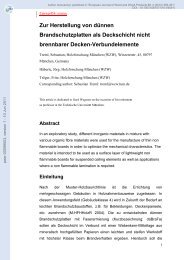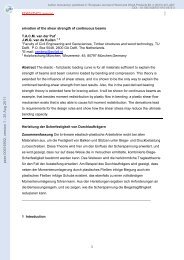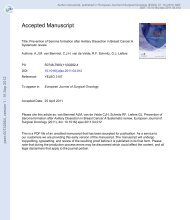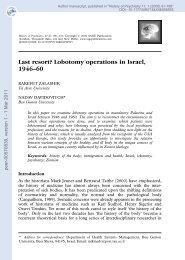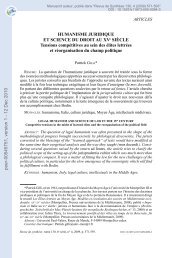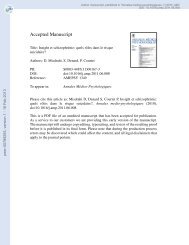Cosheaves and connectedness in formal topology
Cosheaves and connectedness in formal topology
Cosheaves and connectedness in formal topology
You also want an ePaper? Increase the reach of your titles
YUMPU automatically turns print PDFs into web optimized ePapers that Google loves.
peer-00821313, version 1 - 9 May 2013<br />
way to express this is that any map X → 2, where 2 is the discrete space on<br />
two elements, is constant (i.e. factors through an element of 2).<br />
Follow<strong>in</strong>g the st<strong>and</strong>ard topos-theoretic treatment (e.g. [13]), we shall modify<br />
this is two ways.<br />
First, we shall require X to be non-empty. We do not admit ∅ as a connected<br />
space. A constructive way to express this is that, if X is connected, then any<br />
map X → ∅ is constant. This rules out ∅ as a connected space, s<strong>in</strong>ce the identity<br />
map on ∅ does not factor through any element of ∅.<br />
If all maps from X to ∅ or 2 are constant, then by <strong>in</strong>duction the same follows<br />
for maps to any f<strong>in</strong>ite card<strong>in</strong>al {1, . . . , n} (n ∈ N). Classically, it follows that<br />
maps to any discrete space I are constant. The second modification now is to<br />
require this stronger condition explicitly. We say that X is connected if any<br />
map X → I, with I discrete, factors through an element of I.<br />
Example 12. We give an example of a space for which every map to 2 or to 0<br />
is constant, but not every map to a discrete space is. We first describe this <strong>in</strong> the<br />
topos-valid context of sheaves over Sierpiński space S. For this particular case, a<br />
sheaf, most conveniently represented as a local homeomorphism over S, is given<br />
by a function X ⊥ → X ⊤ where the two sets are the stalks for the bottom <strong>and</strong><br />
top po<strong>in</strong>ts ⊥ <strong>and</strong> ⊤ of S. Sheaves are, of course, exactly the notion of discrete<br />
space <strong>in</strong> this context. The discrete 2-element space is given by the projection<br />
S × 2 → S. Let X be the sheaf over S whose stalks are X ⊥ = {0, 1}, X ⊤ = {∗}.<br />
A map (sheaf morphism) from X to 2 must choose one or other element of 2<br />
for the image of ∗, <strong>and</strong> this then forces the same choice of element of 2 for the<br />
images of 0 <strong>and</strong> 1. Hence any map X → 2 is constant. However, the identity<br />
map on X (which is a map from X to a discrete space) is not constant.<br />
We can view this alternatively as a Brouwerian counterexample. Let φ be<br />
some proposition for which ¬¬φ is known, but φ is not. (In SS, φ could be the<br />
subsheaf of 1 with stalks φ ⊥ = ∅, φ ⊤ = 1.) Let X be the set {0, 1} equipped with<br />
an imposed equality such that 0 = 1 if φ. Suppose we have a map f : X → 2.<br />
If φ then 0 = 1 <strong>and</strong> so we must have f(0) = f(1). Hence f(0) ≠ f(1) implies<br />
¬φ, which is impossible, <strong>and</strong> so, s<strong>in</strong>ce equality on 2 is decidable, we must have<br />
f(0) = f(1). It follows that f is constant. However, the identity map on X is<br />
not.<br />
We can express this notion of <strong>connectedness</strong> for <strong>formal</strong> topologies as follows.<br />
Note that, <strong>in</strong> type theoretic terms, by set we mean what is often called a setoid,<br />
i.e. a type equipped with an equivalence relation that serves as a def<strong>in</strong>ed<br />
equality. (This already appeared <strong>in</strong> the example.) The discrete space on a set<br />
I is presented as a <strong>formal</strong> <strong>topology</strong> with base (I, =) <strong>and</strong> cover i ⊳ U if i ∈ U.<br />
The cover relation is <strong>in</strong>ductively generated from the empty set of basic covers.<br />
It follows that a map f from X = (P, ≤, ⊳) to I is given by a family of subsets<br />
A i ⊆ P (i ∈ I) with afi iff a ⊳ A i . We need at least A i ⊳ A j if i = j (so by<br />
symmetry also A j ⊳ A i ), though <strong>in</strong> practice we commonly have A i = A j . We<br />
also need that the A i s cover X (i.e. P ⊳ ⋃ i A i) <strong>and</strong> are pairwise disjo<strong>in</strong>t <strong>in</strong><br />
the sense that A i ↓ A j ⊳ {b ∈ P | i = j} (this is a constructive way of say<strong>in</strong>g<br />
A i ↓ A j ⊳ ∅ if i ≠ j).<br />
11


